Sarajevo, the capital city of Bosnia and Herzegovina, is a melting pot of cultures and history. The city is well-known for its beautiful architecture, vibrant nightlife, and delicious cuisine. If you’re visiting Sarajevo, one of the best ways to explore the city’s culinary scene is by taking a food and drink tour. Sarajevo has a wide range of food tours to suit every taste and budget, so join us as we take a look at some of the best food and drink tours in Sarajevo. Whether you’re a foodie or just looking to explore the city with your taste buds, these tours are bound to leave you satisfied and fully immersed in Sarajevo’s rich culture.
The 2 Best Food & Drink Tours in Sarajevo
The 2 Best Food & Drink Tours in Sarajevo
1. Gourmet Food City Tour
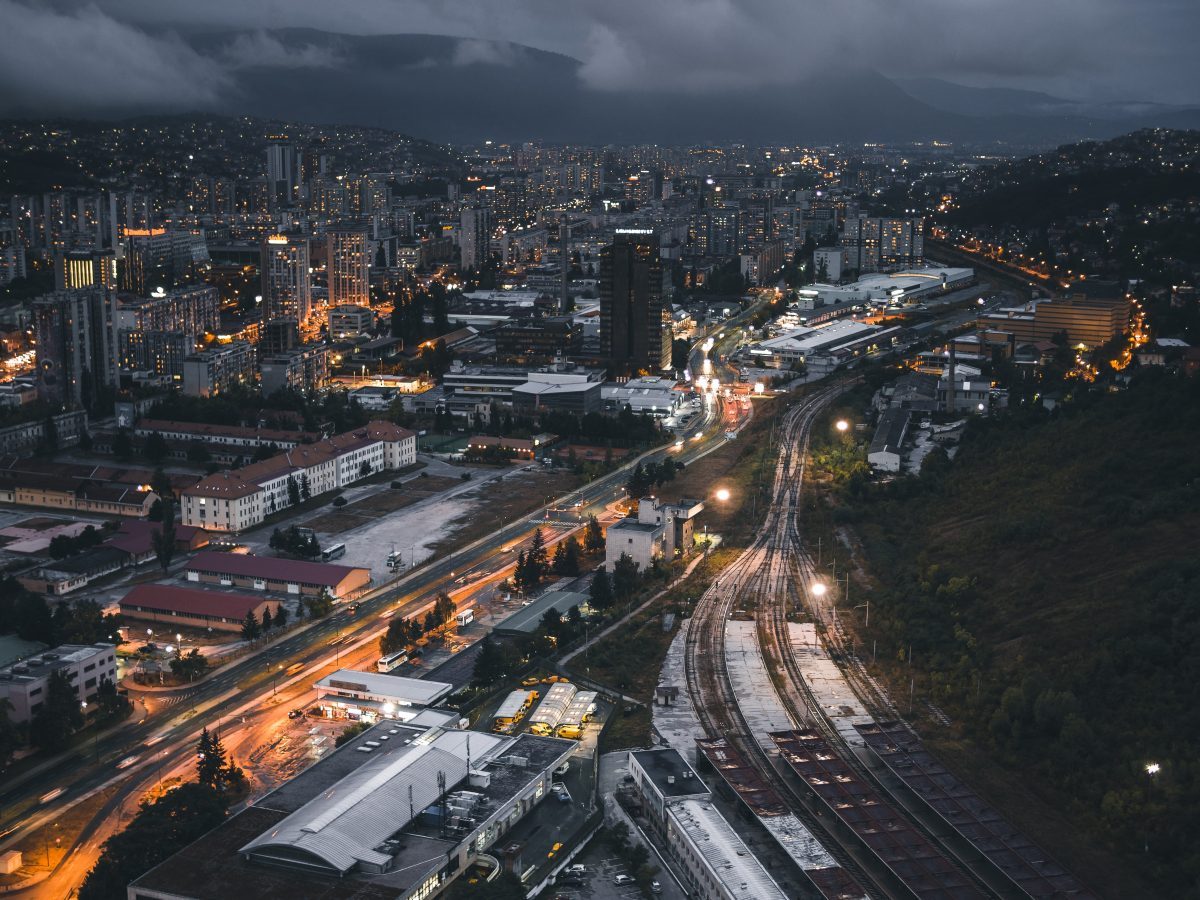
Indulge in the delicious culinary scene of Sarajevo with this walking ‘Gourmet Food City Tour’. Accompanied by a knowledgeable guide, you’ll explore the scenic streets of Sarajevo, enjoying a cultural and gastronomic experience. Sample an array of traditional Bosnian foods, including cured meats, cheeses, and local pies. You’ll also sip homemade Bosnian brandy, adding an extra flourish to an already delightful tasting experience. Highlighting the tour are stops by historic monuments such as cathedrals, squares, and museums, all while learning about the city from your guide. Included in the package are pick-up and drop-off at your hotel, along with local beverages and gratuities. The tour is not wheelchair accessible, with moderate walking involved. Meet your guide at the designated meeting point at Balkantina, with the start time at 11:00 AM, ending back at the same meeting spot. Confirmation will be received at the time of booking.
2. Food Tour Through Neighborhood Grbavica
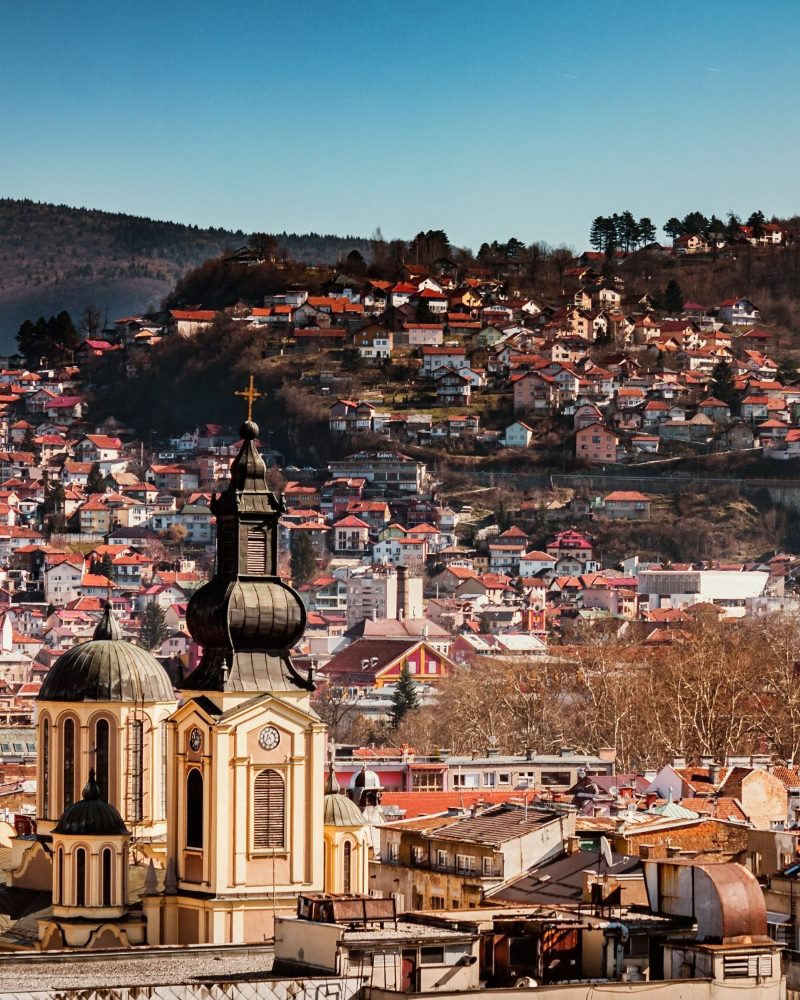
Hardly any other district in Sarajevo has such a turbulent history as Grbavica, which was occupied during the Bosnian War and left in ruins. On this culinary journey, you will experience five local dishes that Bosnians can’t live without and have the opportunity to drink Bosnian craft beer and rakija at a little neighbourhood pub. Explore Sarajevo off the beaten path and learn about the Grbavica neighbourhood, its delicacies, and its socialist-brutalist architecture. A walk through this part of the city will give you an insight into how people live today and the will of the people to revive their Sarajevo. The tour includes a lot of information about the siege of the city and the history of Grbavica. This is an opportunity to discover a lively and sought-after district with numerous restaurants, cafes, and parks that most tourists don’t usually visit.
The Most Frequently Asked Questions about Sarajevo
Sarajevo, the capital of Bosnia and Herzegovina, is a city that has been through a lot. From the assassination of Archduke Franz Ferdinand to the longest siege in modern history, Sarajevo has a unique history and culture that has attracted many visitors from all over the world. However, many tourists have several questions before they visit Sarajevo for the first time. In this blog post, we will answer some of the most frequently asked questions about Sarajevo.1. Is Sarajevo safe?
Sarajevo is generally a safe city, and the crime rate is low. However, like in any big city, you need to be careful of your belongings, especially in crowded areas such as the Baščaršija market. The city also experienced some terrorist attacks during the war in the 1990s, but since then, Sarajevo has rebuilt and become a peaceful city once again.2. What is the best time to visit Sarajevo?
The best time to visit Sarajevo is during the summer months between June and August. The weather is warm, and there are many outdoor events and festivals happening during this time. However, if you want to avoid the crowds and enjoy the beauty of the city in peace, you should visit in the spring or autumn. During wintertime, Sarajevo is also a popular destination for winter sports enthusiasts.3. What are some must-see attractions in Sarajevo?
There are many must-see attractions in Sarajevo, and it depends on your interests. However, some of the most popular attractions include:- The Baščaršija market
- The Sarajevo City Hall
- The Tunnel of Hope
- The Yellow Fortress
- The Olympic Mountains, Bjelašnica and Jahorina
4. What is the food like in Sarajevo?
Sarajevo has a unique blend of Mediterranean and Eastern European cuisine that is worth experiencing. Some of the must-try dishes include:- Ćevapi – grilled minced meat
- Burek – a type of pastry filled with cheese, meat or spinach
- Bosnian coffee – coffee served in a copper pot with a side of Turkish delight
- Karahodžići – rice and mushroom dish
5. What is the transportation like in Sarajevo?
The transportation system in Sarajevo is quite convenient and affordable. You can take a tram, trolleybus or bus to get around the city. The tickets can be purchased at kiosks, and you need to validate your ticket inside the vehicle. Taxis are also available, but be aware that they might overcharge tourists.6. Can I drink tap water in Sarajevo?
Yes, you can drink tap water in Sarajevo, and it is safe. However, some people prefer bottled water, which can be purchased at any store in the city.7. What is the currency in Sarajevo?
The currency in Sarajevo is the Bosnian Convertible Mark (BAM). You can exchange your dollars, euros, or any other currency at the exchange offices or banks in the city. Most places in Sarajevo also accept credit cards.8. Is it necessary to tip in Sarajevo?
Tipping in Sarajevo is not mandatory, but it is customary to leave a small tip if you are satisfied with the service. The usual tip is 10% of the total bill, but you can leave more if you want to show your appreciation.9. What is the language spoken in Sarajevo?
The official language in Sarajevo is Bosnian, and most people also speak English. Some people also speak German, French, or Italian, depending on their exposure to different cultures.10. What should I wear when visiting Sarajevo?
The dress code in Sarajevo is generally casual, but you should dress appropriately when visiting religious sites such as mosques or churches. During the summer months, make sure to wear light clothing and comfortable shoes. During the winter, you should dress warmly, as the temperature can drop below freezing.Conclusion
Sarajevo is a unique and beautiful city that has a rich history and culture. It is also a safe and affordable destination for tourists. In this blog post, we have answered some of the most frequently asked questions about Sarajevo, which will help you plan your visit and make the most out of your trip. Don’t forget the tasty food and beautiful sights. Enjoy your trip to Sarajevo!Sarajevo, the capital city of Bosnia and Herzegovina, is a place that is steeped in history and culture. With a cuisine that is an incredible mix of Ottoman, Austro-Hungarian, and Balkan influences, Sarajevo is renowned for its food and drink. From traditional delicacies to modern twists, there are plenty of options to try. One of the best ways to immerse yourself in the food and drink culture of Sarajevo is by taking a food and drink tour. In this post, we will explore some of the best food and drink tours in Sarajevo that will take you on a culinary journey through the city, tasting local specialties and experiencing the vibrant atmosphere of this fascinating city.
The 2 Best Food & Drink Tours in Sarajevo
The 2 Best Food & Drink Tours in Sarajevo
1. Gourmet Food City Tour
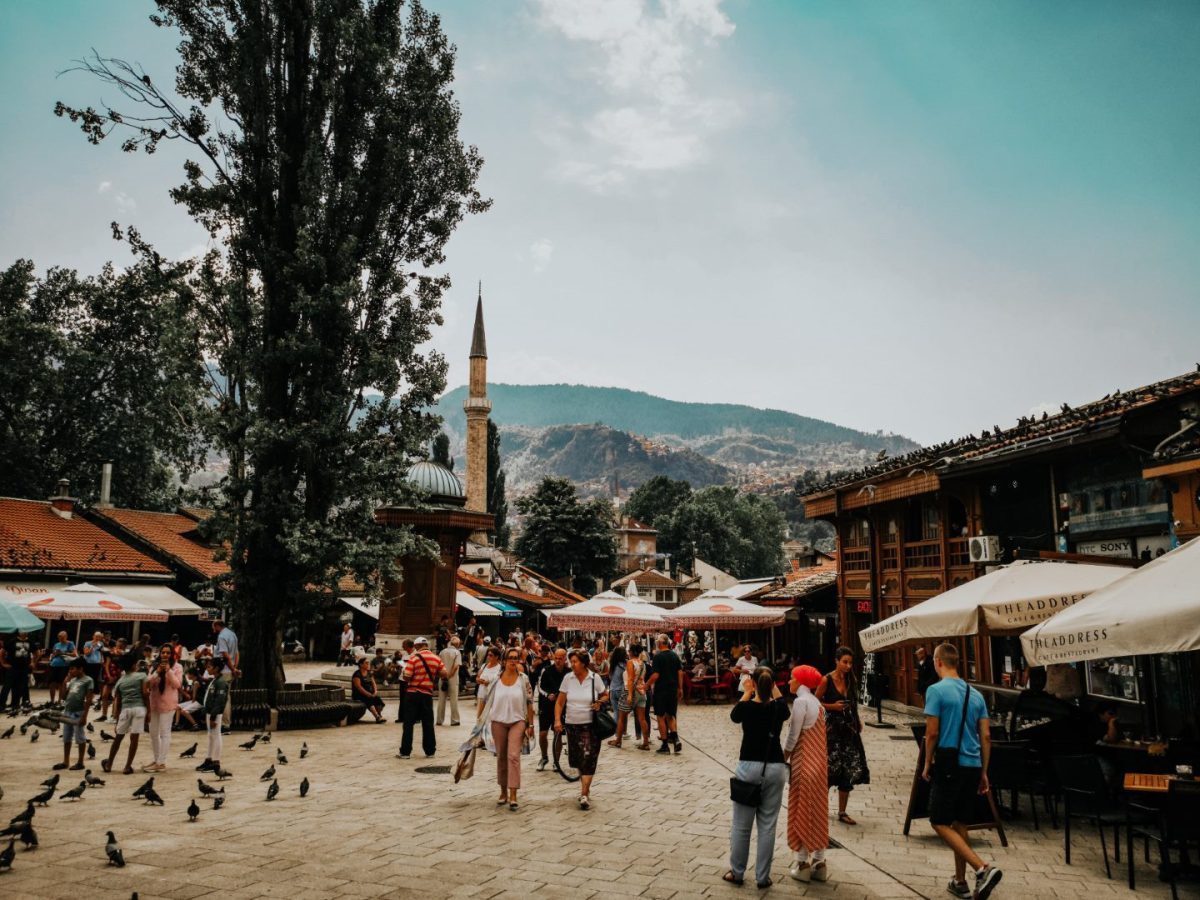
Taste your way through Sarajevo’s culinary scene on a walking tour led by an expert guide. Discover Bosnian culture through food as you stroll scenic streets and stop by a local market to sample cheeses, meats and more. Try Bosnian pie and sip homemade brandy at a restaurant along the way. As you walk, your guide will point out historic cathedrals, museums, war memorials, and other sites of interest. This tour includes hotel pickup and drop-off, food tastings and beverages, and a local guide. Confirmation will be received at the time of booking, and please note that this tour is not wheelchair accessible.
2. Food Tour Through Neighborhood Grbavica

Hardly any other district in Sarajevo has such a turbulent history as Grbavica. The predominantly military neighbourhood was occupied during the Bosnian War – a siege within a siege so to speak – and was left in ruins at the end of the war. Slowly the inhabitants of Grbavica rebuilt their neighbourhood – and today it is a lively sought-after district with numerous restaurants cafés and parks.
Tourists don’t stray here very often but Grbavica’s delicious delicacies and socialist-brutalist architecture are waiting to be discovered and a walk through this part of the city gives an insight into how people live today. On this culinary journey, you’ll try five local dishes Bosnians can’t live without, drink Bosnian craft beer and rakija at a little neighbourhood pub, and ultimately, learn a lot about the siege of the city but also about the will of the people to revive their Sarajevo. Get ready to explore Sarajevo off the beaten path and have a food experience you won’t soon forget.
Frequently Asked Questions About Sarajevo
Sarajevo is one of the most popular cities in Bosnia and Herzegovina. It is known for its rich culture, history, and unique architecture. If you’re planning to visit Sarajevo, you may have some questions about the city. Here are some of the most frequently asked questions about Sarajevo:1. What is the best time to visit Sarajevo?
The best time to visit Sarajevo is during the spring (April-June) and the fall (September-November). The weather is pleasant during these seasons, and there are fewer tourists compared to the summer. Summer is the busiest season, and the city can get crowded. The winters in Sarajevo can be very cold, with temperatures dropping below freezing, so it may not be the best time to visit for those who aren’t used to the cold weather.2. What is the currency used in Sarajevo?
The currency used in Sarajevo is the Bosnia and Herzegovina Convertible Mark (BAM). Most businesses in Sarajevo accept credit cards, but it’s always a good idea to have some local currency on hand, especially if you plan to visit small shops and street vendors. You can exchange your currency at banks and exchange offices throughout the city.3. Is it safe to visit Sarajevo?
Sarajevo is generally a safe city for tourists. However, like any other city, there is some crime, so it’s important to take precautions. Be aware of your surroundings, and avoid carrying large amounts of cash and valuables. It’s also a good idea to stay in well-lit areas at night and avoid walking alone in quiet areas.4. What are the must-see attractions in Sarajevo?
Sarajevo has many attractions that you must see during your visit. Some of these include:- The Old Town (Bascarsija)
- Gazi Husrev-beg Mosque
- Sarajevo City Hall
- Tunnel of Hope
- Sarajevo Olympic Bobsleigh and Luge Track
5. What is the food like in Sarajevo?
Sarajevo is known for its diverse cuisine. You’ll find a mix of traditional Bosnian dishes as well as international cuisine. Some of the must-try dishes in Sarajevo include cevapi (grilled minced meat), burek (a pastry filled with meat or cheese), and tufahija (stewed apples stuffed with walnuts and cream). Be sure to try Bosnian coffee, which is strong and served in a small, copper pot.6. How do I get around Sarajevo?
The best way to get around Sarajevo is on foot. The city center is small, and most of the attractions are within walking distance. You can also take taxis or public transportation, which consists of trams, buses, and trolleybuses. The easiest way to navigate the city is by using a ride-hailing app like Uber or Bolt.7. What are the local customs in Sarajevo?
Bosnians are known for their hospitality, and you’ll likely be greeted with a warm welcome when you visit Sarajevo. It’s customary to remove your shoes when entering someone’s home or a mosque. If you’re invited to someone’s home, it’s polite to bring a small gift for the host, such as sweets or flowers. Dress modestly when visiting mosques or other religious sites.8. What language is spoken in Sarajevo?
The official language of Sarajevo is Bosnian, but many people also speak English. You’ll find that most signs and menus are also translated into English, so it’s easy to get around even if you don’t speak the local language.Conclusion
Sarajevo is a beautiful city with a rich history and culture. It’s a great destination for travelers who want to experience something unique and off the beaten path. By following these tips and recommendations, you’ll be able to enjoy all that Sarajevo has to offer while staying safe and comfortable.Welcome to Sarajevo, the culinary capital of Bosnia and Herzegovina! Known for its rich and diverse food scene, Sarajevo offers a wide variety of delicious local cuisine and unique drinks. If you’re a foodie looking for a fun and memorable gastronomic experience, you won’t be disappointed. In this blog post, we’ll be exploring the best food and drink tours in Sarajevo, taking you on a journey through the city’s culinary history and introducing you to some of the city’s top chefs and restaurants. Get ready to indulge in some mouth-watering delights as we discover the best food and drink tours that Sarajevo has to offer.
The 2 Best Food & Drink Tours in Sarajevo
The 2 Best Food & Drink Tours in Sarajevo
1. Food Tour Through Neighborhood Grbavica
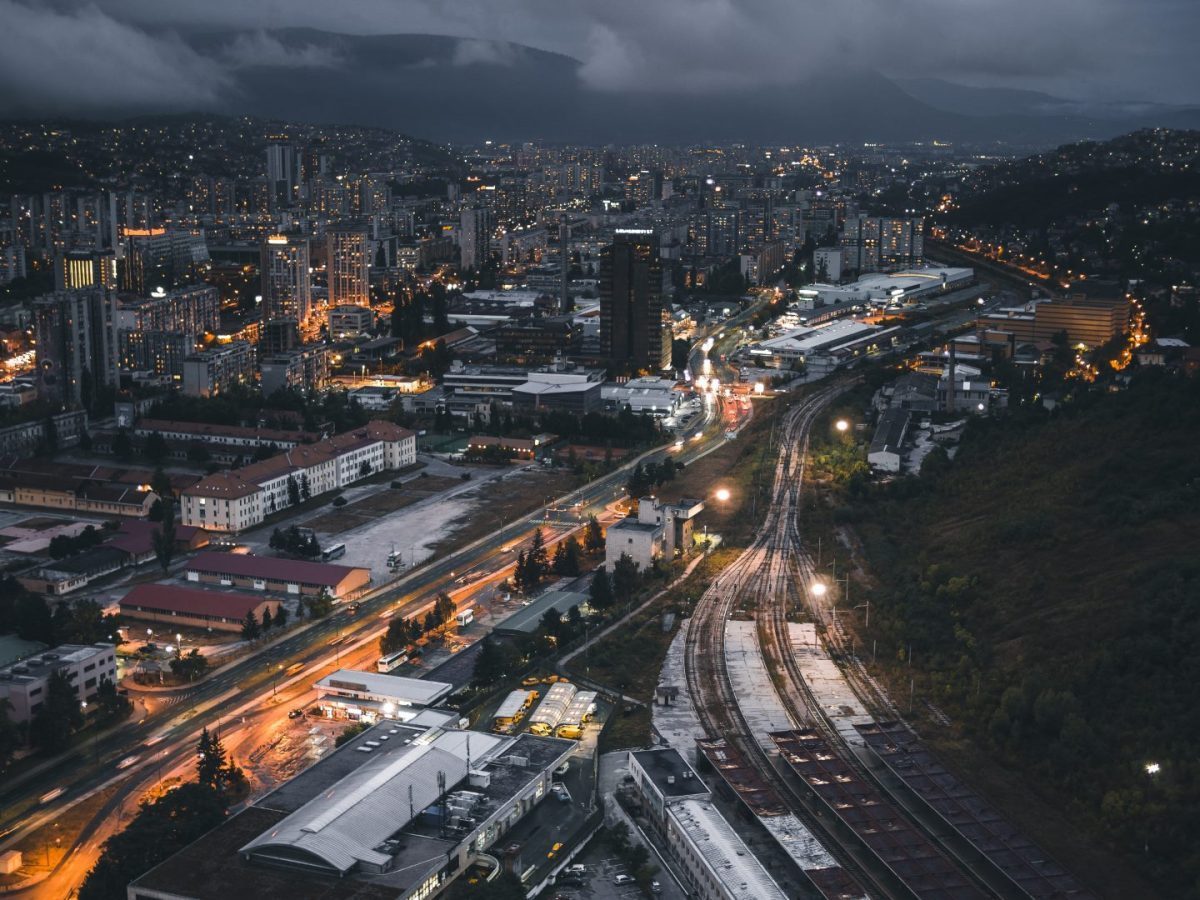
Hardly any other district in Sarajevo has such a turbulent history as Grbavica. The predominantly military neighbourhood was occupied during the Bosnian War – a siege within a siege so to speak – and was left in ruins at the end of the war. Slowly the inhabitants of Grbavica rebuilt their neighbourhood – and today it is a lively sought-after district with numerous restaurants, cafés, and parks.
On this culinary journey, you’ll explore Grbavica, a neighbourhood that is often missed by tourists. Your knowledgeable guide will take you through the streets, showcasing the socialist-brutalist architecture and sharing stories about the neighbourhood’s history.
But what’s a tour without delicious food and drinks? You’ll get to try five local dishes that Bosnians can’t live without. As you walk through Grbavica, you’ll stop by a little neighbourhood pub to sample Bosnian craft beer and rakija, a traditional fruit brandy.
This tour provides an opportunity to explore Sarajevo off the beaten path, learn about the city’s siege and the people’s will to rebuild their lives after the war, and indulge in some of the best local food and drinks.
2. Gourmet Food City Tour
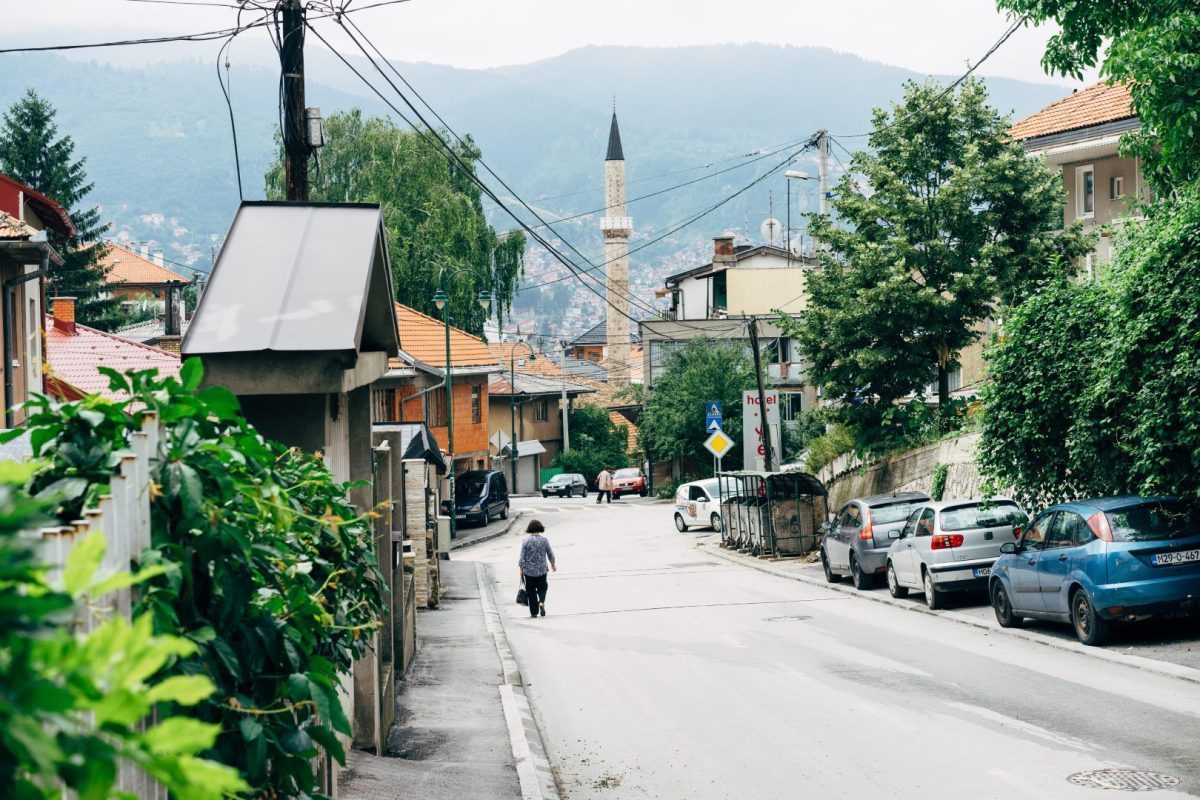
Explore Sarajevo’s bustling food scene on this gourmet walking tour. Led by a knowledgeable local guide, wander through charming streets and bustling markets, and learn about Bosnian culture through its cuisine. Sample a variety of meats, cheeses and prepared dishes, and enjoy a sip of homemade brandy. Along the way, take in the city’s historic sites such as cathedrals, museums and war memorials. With hotel pickup and drop-off included, this tour is the ultimate way to discover the city’s culinary offerings. Please note that this tour is not wheelchair accessible and confirmation will be received at time of booking.
Answering the Most Frequently Asked Questions About Sarajevo
Sarajevo, the capital city of Bosnia and Herzegovina, is a bustling hub of history, culture, and cuisine. For many, it’s an intriguing destination that’s yet to be fully explored, but it’s also a city that’s full of questions for those who want to visit or live there. In this blog post, we’ll take a look at some of the most frequently asked questions about Sarajevo and provide answers that will give you a better understanding of this fascinating city.1. What is the history of Sarajevo?
Sarajevo has a long and diverse history that dates back to the Roman Empire. However, the city is perhaps best known for its role in the events leading up to World War I. It was in Sarajevo that Archduke Franz Ferdinand of Austria and his wife were assassinated, an event that would spark the First World War.The city was also heavily impacted by the Bosnian War in the 1990s, which saw the city under siege for more than three years. Despite the devastation, the city has since rebuilt and is now a vibrant and thriving place.2. What is the best time to visit Sarajevo?
The best time to visit Sarajevo is in the summer months of June, July, and August when the weather is warm and sunny. However, if you want to avoid the crowds and high prices, you may want to consider visiting in May or September. The winter months can be quite cold with snow on the ground, but this can also be a beautiful time to visit if you enjoy winter sports or the holiday season.3. What are the must-see attractions in Sarajevo?
There are plenty of must-see attractions in Sarajevo. Some of the most popular include:- The Sebilj Fountain in Baščaršija, the old town
- The Latin Bridge where Archduke Franz Ferdinand was assassinated
- The Sarajevo Tunnel, which was used during the Bosnian War
- The Gazi Husrev-bey Mosque, which dates back to the 16th century
- The National Museum of Bosnia and Herzegovina, which has a collection of artifacts from the country’s history
4. What is the food like in Sarajevo?
Food is a big part of the culture in Sarajevo. Some of the must-try dishes include:- Cevapi – a type of grilled meat that’s usually served in pita bread with onions and sour cream
- Burek – a savory pastry that’s made with layers of dough and filled with meat or cheese
- Bosnian coffee – a strong, rich coffee that’s served in small cups
- Rakija – a popular fruit brandy that’s often served as an aperitif or digestif
5. What is the transportation system like in Sarajevo?
Sarajevo has a good public transportation system that includes buses and trams. Tickets can be purchased from kiosks or from the driver, and fares are typically very affordable. Taxis are also available, but it’s important to negotiate the price before getting in the car.6. What language is spoken in Sarajevo?
The official languages in Sarajevo are Bosnian, Serbian, and Croatian. However, many people in the city also speak English, especially in tourist areas.7. Is Sarajevo a safe city?
Sarajevo is generally a safe city, but like any urban area, it’s important to take precautions to avoid becoming a victim of crime. It’s recommended to stay aware of your surroundings, especially at night, and to avoid walking alone in unlit areas.8. What is the currency used in Sarajevo?
The currency used in Sarajevo is the Bosnian Convertible Mark (BAM). ATMs are widely available throughout the city, and credit cards are accepted in many shops and restaurants.9. What is the nightlife like in Sarajevo?
Sarajevo has a vibrant nightlife scene, with plenty of bars, clubs, and live music venues to choose from. Some of the most popular areas for nightlife include the old town, Baščaršija, and the student neighborhood of Alipašino Polje.10. Are there any customs or cultural norms to be aware of in Sarajevo?
One thing to keep in mind when visiting Sarajevo is that it’s a predominantly Muslim city. While this doesn’t mean that visitors need to follow strict religious customs, it’s important to be respectful of the local culture. This means dressing modestly when visiting religious sites, avoiding public displays of affection, and avoiding drinking in public during Ramadan.The Verdict
Sarajevo is a fascinating city with a rich history and a vibrant cultural scene. Whether you’re interested in exploring its past, trying its delicious cuisine, or experiencing its nightlife, there’s something for everyone in this dynamic and diverse city. With the information in this blog post, you’ll be well prepared to make the most of your trip to Sarajevo.Welcome to Sarajevo, the charming capital of Bosnia and Herzegovina. Sarajevo is a city that is famous for its rich history and breathtaking architecture, but what many people don’t know is that it also offers an incredible culinary experience. Sarajevo’s old city is a foodie’s paradise, with a vast array of traditional dishes and drinks waiting to be discovered. Join us as we explore the best food and drink tours in Sarajevo, where you can experience the culinary delights of this incredible city and learn about its unique culture and traditions. From sipping on homemade rakija to sampling the best cevapi in town, Sarajevo has something for everyone. Let’s dig in!
The 2 Best Food & Drink Tours in Sarajevo
The 2 Best Food & Drink Tours in Sarajevo
1. Food Tour Through Neighborhood Grbavica
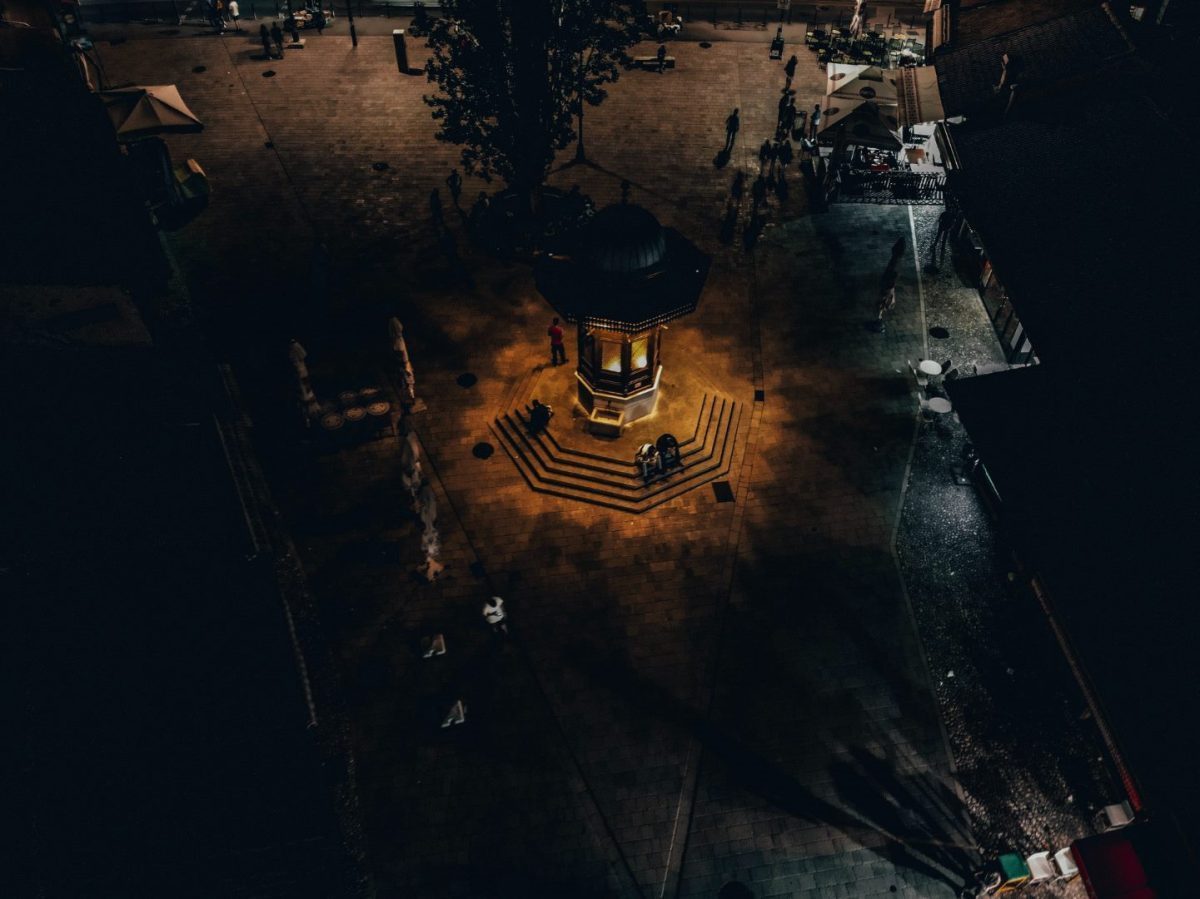
Hardly any other district in Sarajevo has such a turbulent history as Grbavica. The predominantly military neighbourhood was occupied during the Bosnian War – a siege within a siege so to speak – and was left in ruins at the end of the war. Slowly the inhabitants of Grbavica rebuilt their neighbourhood – and today it is a lively sought-after district with numerous restaurants cafés and parks. Tourists don’t stray here very often but Grbavica’s delicious delicacies and socialist-brutalist architecture are waiting to be discovered and a walk through this part of the city gives an insight into how people live today. On this culinary journey, you’ll try five local dishes Bosnians can’t live without and drink Bosnian craft beer and rakija at a little neighborhood pub. You’ll also explore Sarajevo off the beaten path and learn about the Grbavica neighborhood. You’ll get to learn a lot about the siege of the city but also about the will of the people to revive their Sarajevo.
2. Gourmet Food City Tour

Taste your way through Sarajevo on this culinary walking tour. In the company of a local guide, stroll the city’s scenic streets, visit a local market and sample cheeses, cured meats, and prepared foods. Stop by a restaurant and try Bosnian pie and sip homemade brandy. As you walk, admire historic cathedrals, squares, museums, war memorials, and more, all while learning about Bosnian culture through food. The tour includes beverages, food tasting, local guide, hotel pickup and drop-off, and gratuities. The meeting point is in front of Balkantina Gourmet Shop, behind Sacred Heart Cathedral, next to the Music Academy. The activity starts at 11:00 AM and ends back at the meeting point. Please note that confirmation will be received at the time of booking and this tour is not wheelchair accessible.
Frequently Asked Questions About Sarajevo
Sarajevo, the capital city of Bosnia and Herzegovina, is a unique and fascinating place. It has a rich history, distinctive culture, and natural beauty that attracts visitors from all over the world. If you’re planning a trip to Sarajevo, you may have some questions about the city. In this blog post, we’ll answer some of the most frequently asked questions about Sarajevo.1. What is the best time to visit Sarajevo?
Sarajevo has a continental climate with hot summers and cold winters. The best time to visit Sarajevo is from April to June or from September to November. During these months, the weather is mild and pleasant, and there are fewer tourists. July and August are the peak tourist months, and the city can be crowded and hot. Winter is also a good time to visit Sarajevo, especially if you’re interested in winter sports.2. What are some must-see attractions in Sarajevo?
There are many must-see attractions in Sarajevo. Here are a few:- The Bascarsija
- The Sarajevo War Tunnel
- The Gazi Husrev-beg Mosque
- The Latin Bridge
- The National Museum of Bosnia and Herzegovina
3. What can I expect from Sarajevo’s traditional food?
Sarajevo has a rich culinary tradition that blends Ottoman, Austro-Hungarian, and Balkan influences. Some must-try dishes include:- Cevapi – grilled sausages served with pita bread, onions, and sour cream
- Burek – a savory pastry filled with meat or cheese
- Bosnian pot – a stew made with beef, vegetables, and paprika
- Baklava – a sweet pastry made with layers of filo pastry, nuts, and honey
4. Is Sarajevo safe for tourists?
Sarajevo is a safe city for tourists. However, like all cities, there are some areas that are safer than others. It’s best to stick to well-lit and busy areas, especially at night. Petty crimes such as pickpocketing can occur in tourist areas, so it’s important to be vigilant.5. What is the best way to get around Sarajevo?
The best way to get around Sarajevo is by foot. The city center is compact, and many of the must-see attractions are within walking distance of each other. If you need to go further, there are trams and buses that run throughout the city. Taxis are also available, but they can be expensive.6. What souvenirs should I buy in Sarajevo?
Sarajevo has a rich tradition of arts and crafts, and there are many unique souvenirs to buy. Some popular items include:- Copperware – handcrafted copper trays, jugs, and vases
- Bosnian coffee set – a traditional set including a brass coffee pot, cups, saucers, and a serving tray
- Sarajevo rose – a symbol of resilience, made by filling bullet holes with red resin
- Handicrafts – items like handmade woolen carpets, woolen slippers, and leather goods
7. What is the currency in Sarajevo?
The currency in Sarajevo is the Bosnian Convertible Mark (BAM). It’s best to exchange your currency for BAM when you arrive in Sarajevo, as many shops and restaurants only accept cash. There are ATMs throughout the city where you can withdraw BAM.8. What language do they speak in Sarajevo?
The official language of Sarajevo is Bosnian, which is one of three official languages in Bosnia and Herzegovina. However, many people in Sarajevo also speak English.Conclusion
Sarajevo is a unique and fascinating city with a rich history, culture, and natural beauty. We hope this blog post has answered some of the most frequently asked questions about Sarajevo and has helped you plan your trip. Remember to be respectful of the city’s history and culture and to enjoy all that Sarajevo has to offer.Sarajevo, the capital of Bosnia and Herzegovina, is a fascinating city full of history, culture, and incredible food. From traditional Bosnian cuisine to international fusion dishes, Sarajevo is a food lover’s paradise. And what better way to experience the city’s culinary scene than by taking a food and drink tour? In this post, we’ll be featuring the best food and drink tours in Sarajevo, each offering a unique perspective and experience of the city’s cuisine. Whether you’re a seasoned foodie or just looking to explore some new flavors, these tours are not to be missed. So grab your appetite and let’s dive in!
The 2 Best Food & Drink Tours in Sarajevo
The 2 Best Food & Drink Tours in Sarajevo
1. Food Tour through neighborhood Grbavica
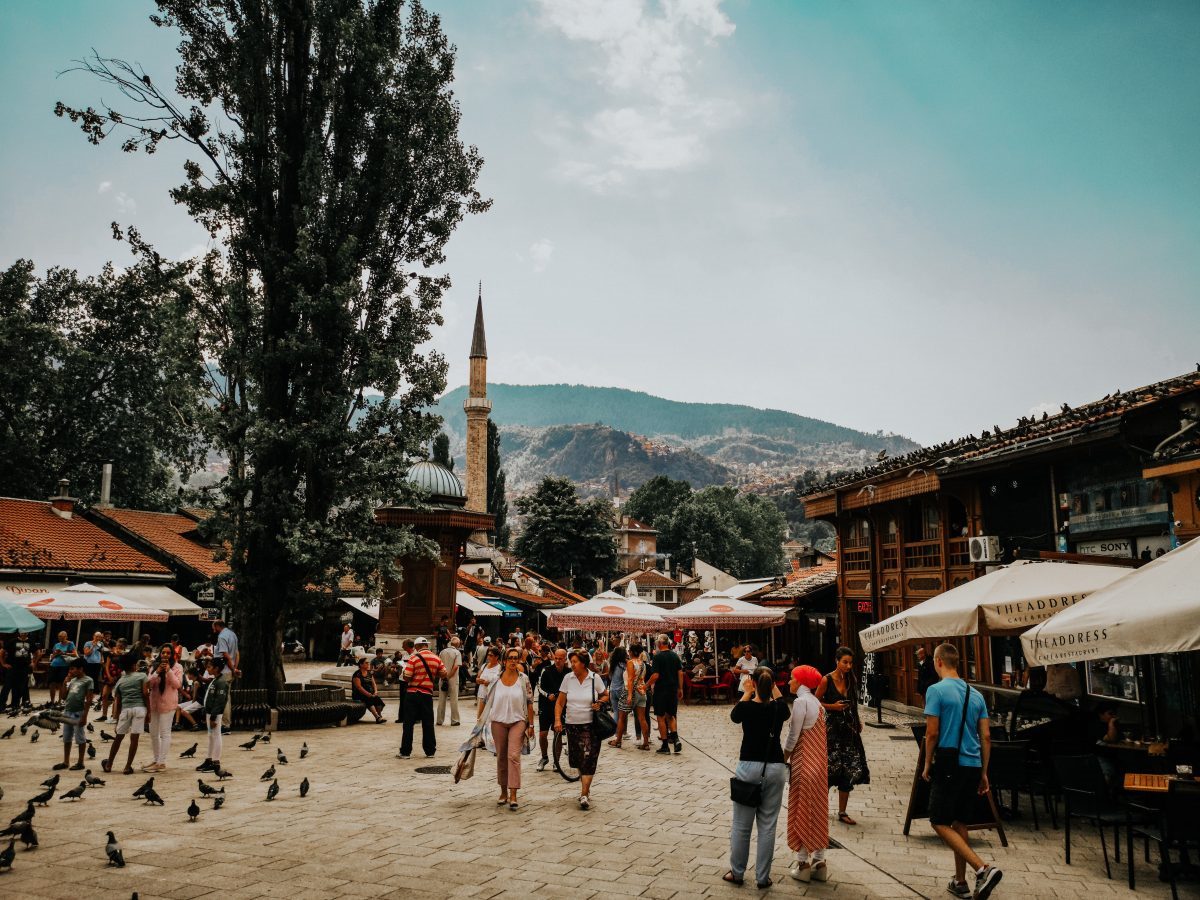
Hardly any other district in Sarajevo has such a turbulent history as Grbavica. The predominantly military neighbourhood was occupied during the Bosnian War – a siege within a siege so to speak – and was left in ruins at the end of the war. Slowly the inhabitants of Grbavica rebuilt their neighbourhood – and today it is a lively sought-after district with numerous restaurants cafés and parks.
Tourists don’t stray here very often but Grbavica’s delicious delicacies and socialist-brutalist architecture are waiting to be discovered and a walk through this part of the city gives an insight into how people live today.
On this culinary journey you’ll learn a lot about the siege of the city but also about the will of the people to revive their Sarajevo. You will try five local dishes Bosnians can’t live without and drink Bosnian craft beer and rakija at a little neighbourhood pub. You’ll explore Sarajevo off the beaten path and learn about the Grbavica neighbourhood.
2. Gourmet Food City Tour
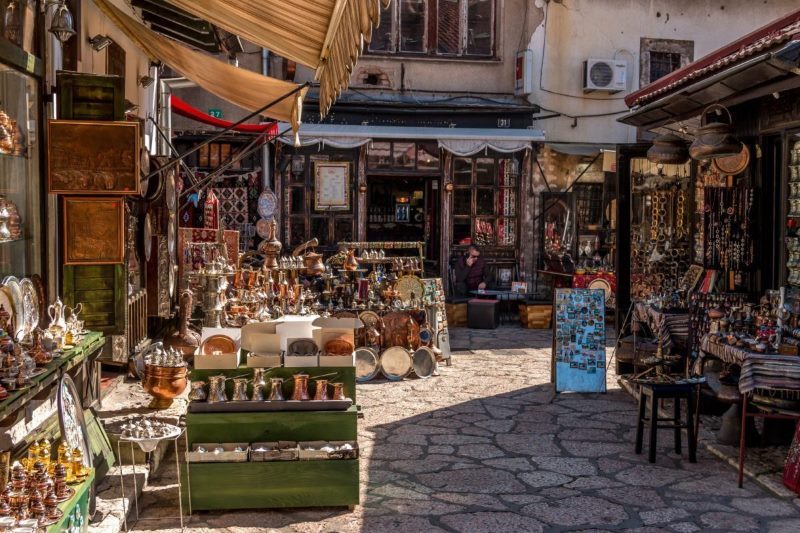
Taste your way through Sarajevo on this culinary walking tour. Accompanied by a guide, stroll through the city’s streets while learning about Bosnian culture through food. Visit a local market and sample cheeses, cured meats, and other prepared foods. Stop by a restaurant and taste traditional Bosnian pie, while sipping on homemade brandy. Along the way, take in the sights of historic cathedrals, squares, museums, war memorials, and more. The tour includes beverages, food tastings, and the services of a local guide. Hotel pickup and drop-off, as well as gratuities are also included. The tour begins at Balkantina Gourmet Shop, behind Sacred Heart Cathedral, next to the Music Academy. The tour is not wheelchair accessible and has a moderate level of activity. The confirmation is received upon booking. The meeting time is at 11:00 AM, and the activity ends back at the meeting point.
Answering the Most Frequently Asked Questions About Sarajevo
Sarajevo, the capital of Bosnia and Herzegovina, is a city with a rich history, diverse culture, and stunning scenery. As with any travel destination, there are always questions to be asked about the city. In this blog post, we will answer the most frequently asked questions about Sarajevo.1. What is the best time to visit Sarajevo?
Sarajevo has a continental climate, meaning it has four distinct seasons. The best time to visit depends on your preferences. – Spring (March to May) and autumn (September to November) are a good choice for mild weather and lower crowds.- Summer (June to August) is the peak tourist season with warmer weather and an abundance of outdoor festivals and events.- Winter (December to February) is ideal for winter sports enthusiasts, as there are several ski resorts near Sarajevo.2. What is the currency in Sarajevo?
The official currency in Bosnia and Herzegovina is the Convertible Mark (KM). Exchange offices and ATMs are widely available around the city, and credit cards are generally accepted in most businesses.3. What language is spoken in Sarajevo?
The official languages spoken in Bosnia and Herzegovina are Bosnian, Croatian, and Serbian. However, in Sarajevo, English is widely spoken, especially in the tourism industry.4. What are some must-visit attractions in Sarajevo?
Sarajevo has a plethora of attractions to explore. Here are some of the must-visit attractions:- Baščaršija: Sarajevo’s old bazaar, where you can explore traditional Bosnian crafts, enjoy local food, and see historical monuments.- Latin Bridge: The spot where Archduke Franz Ferdinand was assassinated in 1914, paving the way for World War I.- Sarajevo City Hall: A magnificent neo-Moorish building that was destroyed during the Bosnian War and later rebuilt.- Yellow Fortress: An ancient fortress that provides spectacular views of Sarajevo.5. Is Sarajevo safe for tourists?
Sarajevo is generally a safe city for tourists. However, as with any travel destination, it’s always recommended to take the usual precautions, such as keeping your valuables safe and being aware of your surroundings.6. What is the local cuisine in Sarajevo?
Sarajevo’s cuisine is a mix of Ottoman, Austro-Hungarian, and Balkan influences. Some of the must-try dishes include:- Ćevapi: Grilled meat served in a pita bread with onions and sour cream.- Bosnian Pot: A hearty stew of meat and vegetables.- Baklava: A sweet pastry made with layers of filo, honey, and nuts.- Sarajevsko Beer: A locally brewed beer that has been produced since the 19th century.7. What are some interesting day trips from Sarajevo?
Sarajevo is centrally located, making it an excellent base for day trips to nearby destinations. Some of the most popular day trips from Sarajevo include:- Mostar: A charming town, famed for its stunning bridge and old town.- Visegrad: A town with a rich Ottoman history, situated on the River Drina.- Lukomir: The highest and most remote village in Bosnia and Herzegovina, known for its traditional way of life.Conclusion
Sarajevo is a wonderful city to visit, with plenty of attractions to explore, delicious food to taste, and interesting day trips to take. By answering the most frequently asked questions about Sarajevo, we hope that we’ve helped you plan your trip better. Remember, as a tourist, it’s always recommended to be respectful of the local culture and traditions. Enjoy your visit to Sarajevo!Sarajevo, the capital city of Bosnia and Herzegovina, is one of the most fascinating cities in Europe. Its rich history and diverse cultural background have made it a melting pot of different flavors and aromas, resulting in a unique and delicious cuisine. For food and drink enthusiasts, Sarajevo is a paradise, offering a wide range of food tours that will take you on a culinary journey you will never forget. In this post, we will take a closer look at some of the best food and drink tours in Sarajevo, where you can indulge in traditional Bosnian cuisine, discover local specialties, and experience the city’s vibrant food scene like a true insider.
The 2 Best Food & Drink Tours in Sarajevo
The 2 Best Food & Drink Tours in Sarajevo
1. Food Tour through neighborhood Grbavica
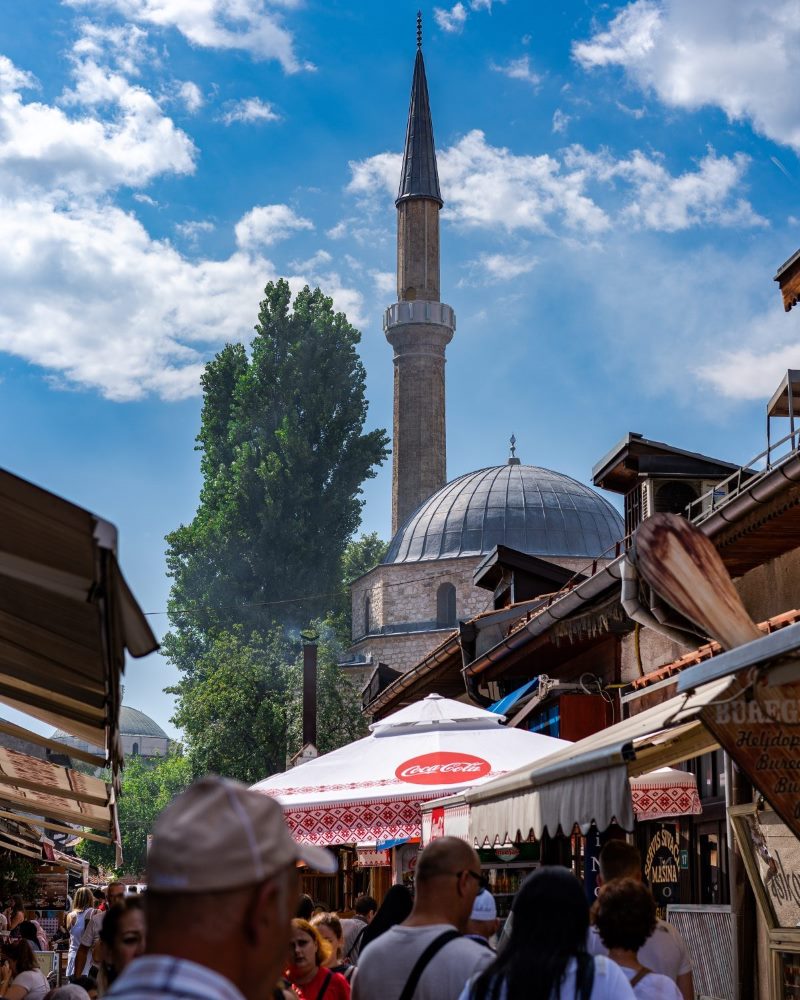
Experience the tastes and history of Sarajevo’s Grbavica neighborhood with this unique culinary tour. Discover five local dishes that are vital to Bosnian cuisine and sample Bosnian craft beer and rakija at a charming neighborhood pub. As you explore the streets of Grbavica, you’ll learn about the district’s history, including its occupation during the Bosnian War, and the remarkable will of its inhabitants to rebuild and reinvigorate their neighborhood. With its rich history, delicious cuisine, and distinctive architecture, Grbavica is a must-visit for anyone interested in experiencing Sarajevo off the beaten path.
2. Gourmet Food City Tour

Taste the best of Sarajevo’s cuisine on this culinary walking tour. Your guide will take you through the picturesque streets of the city, while introducing you to traditional Bosnian cuisine. You’ll explore a local market, where you’ll have the chance to taste cured meats, cheeses, and other prepared foods. Afterward, you’ll visit a restaurant to try Bosnian pie and sip homemade brandy. Admire the city’s famous landmarks, including historic cathedrals, squares, museums, and war memorials, and learn about the city’s culture and history from your knowledgeable guide. This tour includes beverages, food tastings, and round-trip transportation from your hotel. Please note that this tour is not wheelchair accessible and has a moderate level of physical activity. Confirm your booking at the Balkantina meeting point at least 24 hours in advance.
The most frequently asked questions about Sarajevo – A comprehensive guide
Are you planning a trip to Sarajevo and wondering what to expect? Do you have questions about the history and culture of this fascinating city? In this post, we’ll answer some of the most frequently asked questions about Sarajevo, giving you all the information you need to make the most of your visit.1. What is the history of Sarajevo?
Sarajevo has a long and complex history, with influences from many different cultures and empires. The city was founded by the Ottomans in the 15th century, and was an important centre for trade and cultural exchange. In the 19th century, it was ruled by the Austro-Hungarian Empire, which brought further development and modernisation.Sarajevo is perhaps best known for its role in the events leading up to World War I. In 1914, Archduke Franz Ferdinand of Austria-Hungary was assassinated in the city, sparking a series of events that eventually led to the outbreak of the war. Sarajevo was heavily bombed during the Bosnian War of the 1990s, but has since been rebuilt and is now a thriving cultural and economic centre.2. What are the main attractions in Sarajevo?
Sarajevo has plenty to offer visitors, from historic landmarks to cultural events and natural beauty. Some of the must-see attractions include:- The historic old town, or Baščaršija, with its narrow streets, traditional cafes and market stalls
- The Latin Bridge, where Archduke Franz Ferdinand was assassinated
- The Yellow Fortress, which offers stunning views over the city
- The Sarajevo Tunnel Museum, which tells the story of the city’s siege during the Bosnian War
- The National Museum of Bosnia and Herzegovina, which has an extensive collection of artefacts from the country’s history
- The Vrelo Bosne park, where you can go for a walk and enjoy the beautiful nature
3. What is the food like in Sarajevo?
Sarajevo has a rich culinary tradition, with influences from the Ottoman and Austro-Hungarian periods as well as local ingredients and flavours. Some of the most popular dishes include:- Cevapi – small grilled sausages served with bread, onions and a side of ajvar (a red pepper relish)
- Burek – a flaky pastry filled with meat, cheese or spinach
- Bosanski Lonac – a meat and vegetable stew, often served with polenta
- Kadaif – a sweet pastry made with shredded phyllo dough and honey syrup
- Tufahije – poached apples stuffed with walnuts and served with cream
4. What is the weather like in Sarajevo?
Sarajevo has a continental climate, with cold winters and hot summers. The temperature in winter can drop below freezing, while in summer it can be above 30°C. The best time to visit Sarajevo is in spring or autumn, when the weather is mild and the city is less crowded.5. What is the currency in Sarajevo?
The currency in Bosnia and Herzegovina is the convertible mark (BAM). It is pegged to the euro, which means that the exchange rate is stable. You can exchange money at banks, exchange offices or some hotels, and there are also plenty of ATMs in the city.6. What is the language in Sarajevo?
The official language of Bosnia and Herzegovina is Bosnian, which is similar to Serbian and Croatian. Many people in Sarajevo also speak English, especially in the tourist areas, and you may also hear German, French and Italian.7. Is Sarajevo safe?
Sarajevo is generally a safe city, with a low crime rate and friendly locals. However, as with any city, it’s important to take sensible precautions to avoid theft or other crimes. Avoid walking alone at night in unfamiliar areas and keep your valuables in a safe place.8. How do I get around Sarajevo?
Sarajevo has a good public transport system, including buses and trams, which are cheap and easy to use. Taxis are also available, but make sure to negotiate the price in advance. If you prefer to walk, the city is compact and easy to navigate on foot, especially in the old town.Conclusion
Sarajevo is a fascinating city with a rich history and culture. Whether you’re interested in its Ottoman heritage or its more recent struggles, you’ll find plenty to discover here. With this guide to the most frequently asked questions about Sarajevo, you’re well equipped to make the most of your visit. Don’t forget to try the cevapi and burek, and take the time to explore the old town and its hidden corners.Table of Contents

